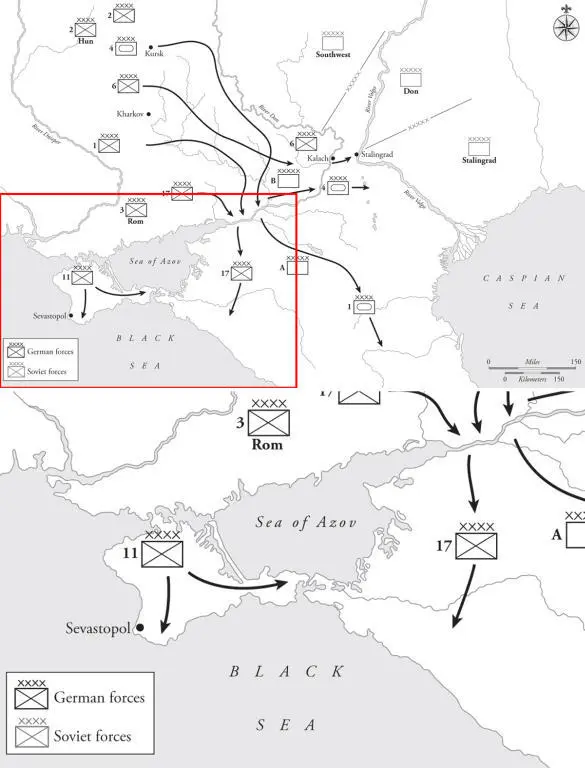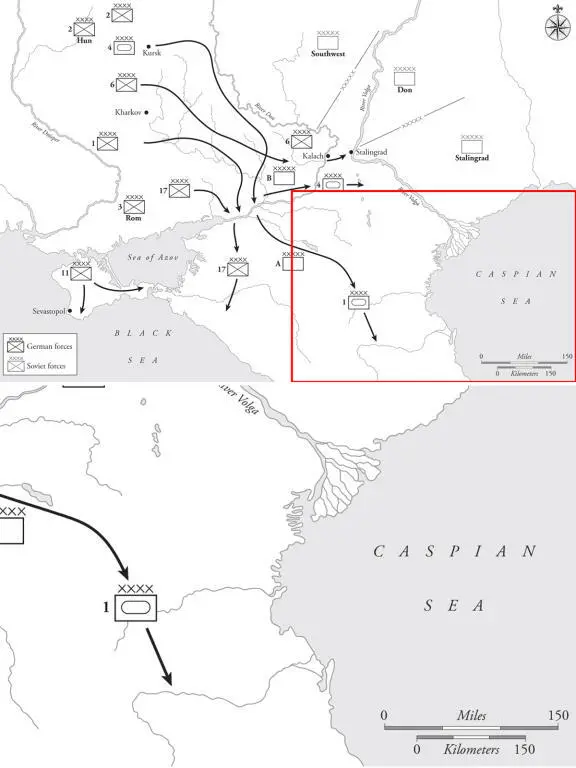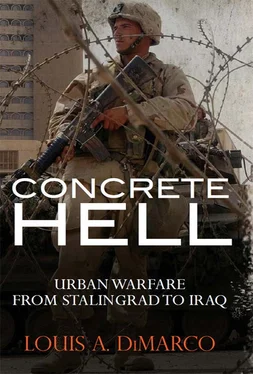The Soviets Avoid Destruction
As the summer of 1942 approached, the Germans determined to reopen the offensive on the Russian front. This time, however, they would not only focus their efforts, but their chosen objective would greatly increase their strategic capabilities to pursue the war to victory: the Caucasus oil fields in southern Russia. The Germans devoted the entire Southern front to this effort. The new offensive was called Operation Blue. The Germans divided Army Group South into two Army Groups, A and B. These army groups were the primary forces in the initial attack. Army Group A, attacking in the south, would be the main effort with the mission of actually capturing the oil fields. Army Group B, to the north of Army Group A, was the supporting attack with the mission of protecting Army Group A’s left flank from a Soviet threat from the north. The Volga River was designated as the limit of the advance of Army Group B. The Germans envisioned Army Group B leading the attack before forming a defensive line along the Volga River to protect the main effort. Army Group A would then assume the lead and attack south into the Caucasus Mountains and secure control of the Caucasus oil fields. The success of the Southern Front offensive would inflict significant combat losses on the Soviets, gain a vital strategic resource for the Reich, and deny that same resource to the Soviet Union.
Army Group B, under the command of Field Marshal Fedor von Bock was composed of two subordinate armies, the Sixth Army under General der Panzertruppe Friedrich Paulus, and the Fourth Panzer Army under Generaloberst Hermann Hoth. Of the two, the Fourth Panzer Army was initially the more powerful formation, consisting of two panzer corps and two infantry corps, including a total of four panzer divisions. In contrast, the Sixth Army commanded two infantry and one panzer corps. The Fourth Panzer Army was initially located north in Army Group B’s sector and was the main attack. The Sixth Army was in the south of the army group sector and had the task of supporting the attack of Fourth Panzer Army. The city of Stalingrad was located in the center of the Sixth Army’s sector.
In late June 1942 Operation Blue was launched, a little later than originally planned. In July 1942, Fuhrer Directive No. 45 changed the course of the campaign and confirmed changes that had already occurred in the original plan. By this point in the campaign Army Group B commander, Field Marshal von Bock, had been relieved of command and replaced by Generaloberst Freiherr Maximilian von Weichs. The Fourth Panzer Army was de-emphasized in the new campaign plan, and XXVIII Panzer Corps and the 24th Panzer Division were moved from Fourth Panzer Army to General Paulus’ Sixth Army’s control. The Fourth Panzer Army itself was transferred to the control of Army Group A. The Fuhrer’s order upgraded Stalingrad to a major objective in the campaign. Finally, the attacks by Army Groups A and B were directed to occur simultaneously rather than sequentially as originally conceived. The plan as directed under Directive No. 45 became the basis of the remainder of the campaign.
The Soviets expected the Germans to resume their offensive in the summer of 1942, but they didn’t expect it to be in the south. Instead, the Soviets expected the Germans to resume their offensive in central Russia with the objective of capturing Moscow. The Soviet strategy in the summer of 1942, though, was largely governed by the leader of the Soviet Union, Joseph Stalin. Stalin insisted that the Red Army continue the counterattacks that had been initiated the previous winter as Operation Barbarossa stalled. Thus, just prior to the Germans launching Operation Blue, Soviet forces attacked further north. Eventually, after the initiation of Operation Blue the Soviet high command discerned that the German main effort was aiming south across the Don River and on to the Volga River.
The Soviet armies facing the German offensive were not the same armies that the Germans had decisively defeated the previous summer and fall. The Soviet commanders who had survived the onslaught of the previous year were a hardened and much smarter group of leaders. The ones who had failed in 1941 had been killed, captured, or arrested. Those that remained had learned important lessons about how to survive fighting against blitzkrieg. They understood that the concept of kettleschlag — the entrapment battle — was fundamental to German success. Thus, as the Germans launched their summer offense in 1942, they found it harder to conduct the large and successful entrapment operations that had characterized Operation Barbarossa the previous year. In the summer of 1942, Soviet commanders increasingly used their tank forces to slow the panzer spearheads and quickly marched their infantry out of threatening German envelopment attacks. This became easier for Soviet commanders to do over the course of the summer as Stalin realized that he could not micromanage the Red Army to victory, and increasingly turned over control of daily operations to the Soviet high command, Stafka, and individual field commanders. In the field, Stalin’s de-emphasis on political control of the military was reflected by the diminished role of political commissars who had previously been practically co-commanders of Soviet military units. Over the course of 1942 commissars were clearly placed subordinate to professional military officers on all matters related to tactical and operational decisions. This change became official in all Soviet forces in September 1942, and greatly increased the flexibility and effectiveness of Soviet commanders.
The city of Stalingrad, upgraded to a major campaign objective, was in the sector of the German Sixth Army. When World War II started, the city of Stalingrad was a major industrial center with a large population of about half a million people. Today, called Volgograd, the modern city is located on the same site as the original, approximated 200 miles north of the Caspian Sea on the west bank of the Volga River. The city’s layout was unusual for several reasons. First, it was not symmetrical. Stalingrad’s geographic shape was that of a very long rectangle that extended about 14 miles north to south along the west bank of the river, and was at its widest only about five miles from east to west. The Volga River east of Stalingrad was about a mile wide and thus a very significant obstacle.
Despite some attempts to evacuate portions of the city’s population, the war industry capability of the city was deemed too important for it to be shut down. Therefore, many civilians remained in the city operating the various war-related facilities, especially the munitions and tank factories. The city was also a magnet for refugees fleeing east before the advancing German army. Soviet industrial facilities in the city continued to operate as the battle raged and only stopped as Soviet troops retreated. Thus, through the bulk of the fighting for the city environs, more than 600,000 civilians remained in the city. To the German military, the presence of the civilians did not affect operations at all. To the Russians, the civilians were a necessary part of the defense. They were organized into labor units that assisted in building defensive positions and they continued to work in the industrial facilities. As those facilities were gradually captured by the Germans the civilian population fled or were ferried to the east side of the river. Throughout the most intense fighting for the city as many as 50,000 civilians remained within the area of the battle.
Map 2.1 German Summer Offensive, 1942



 Читать дальше
Читать дальше
















